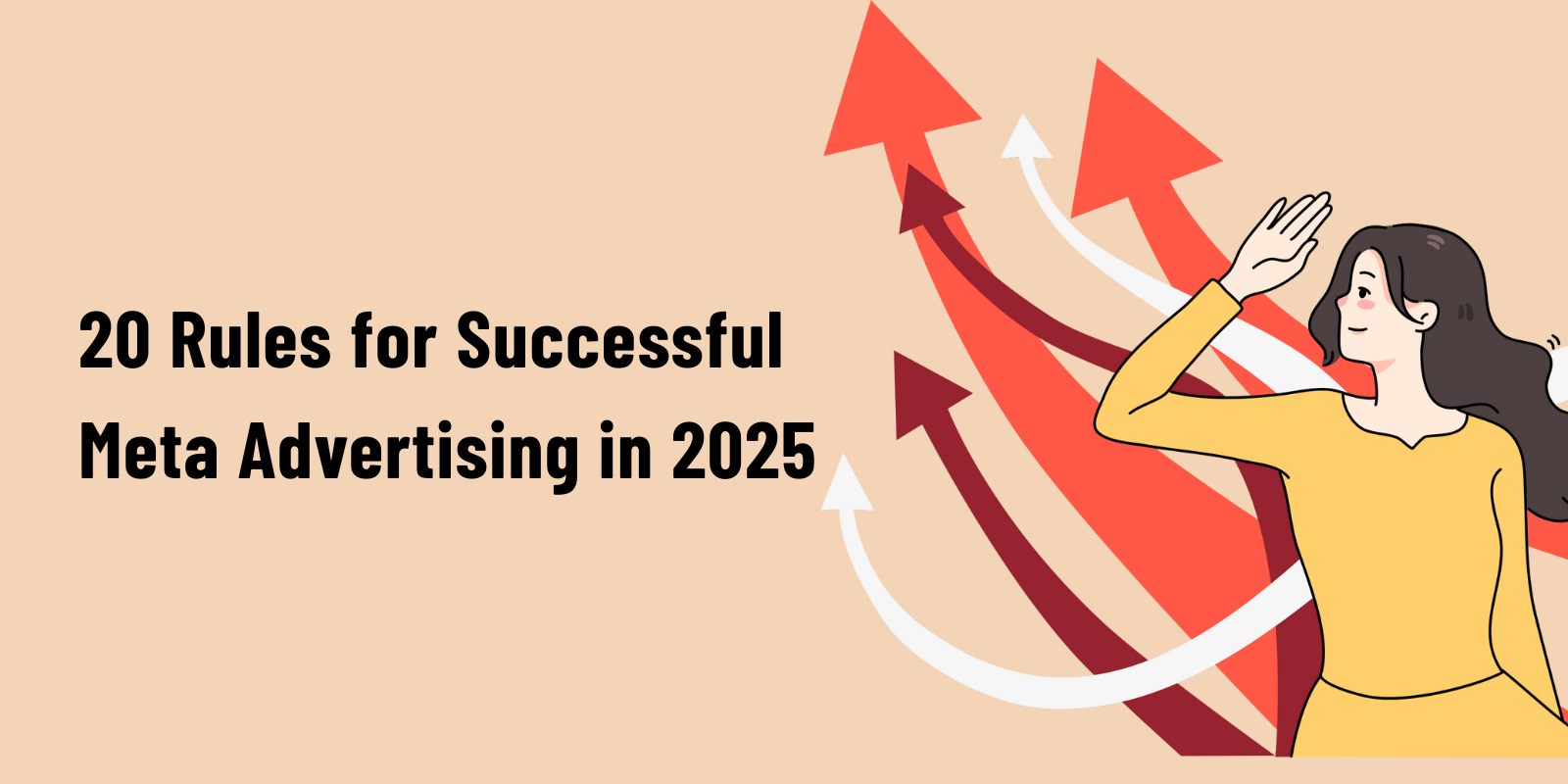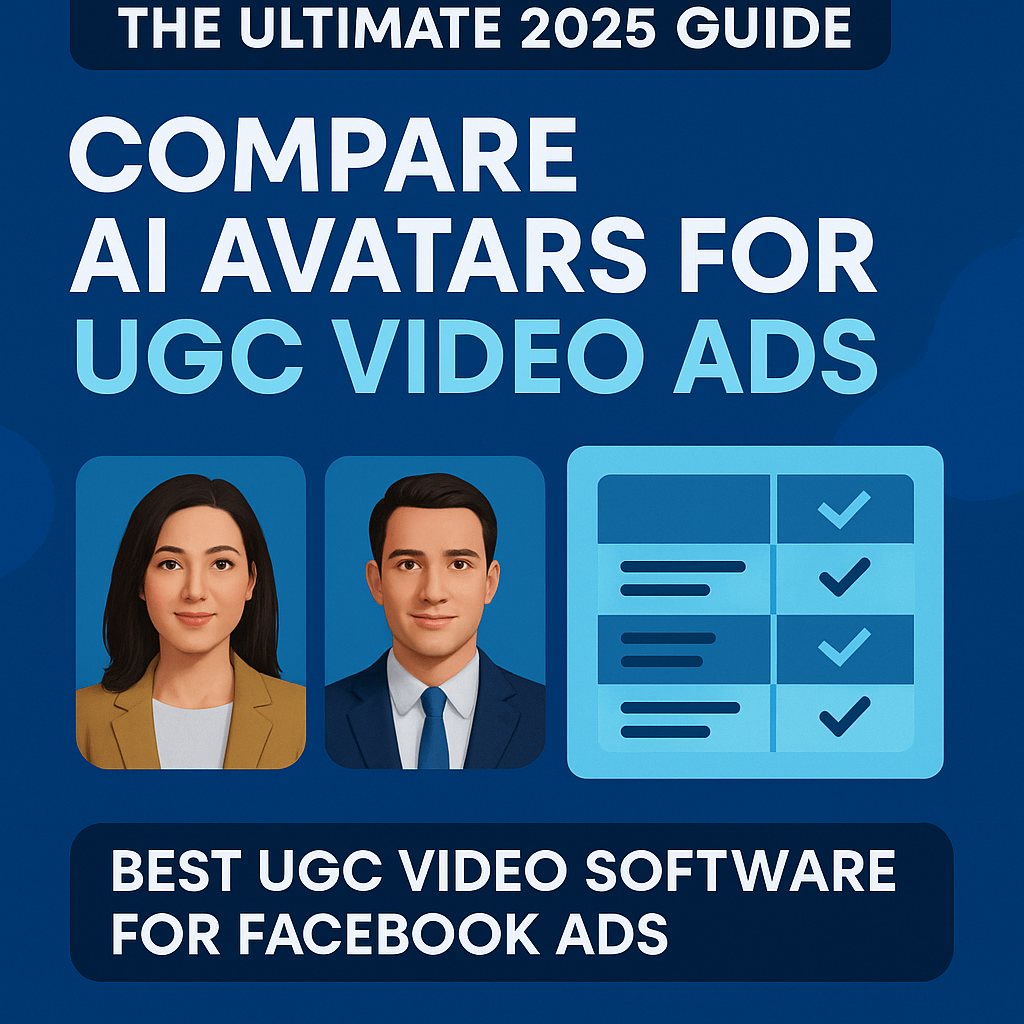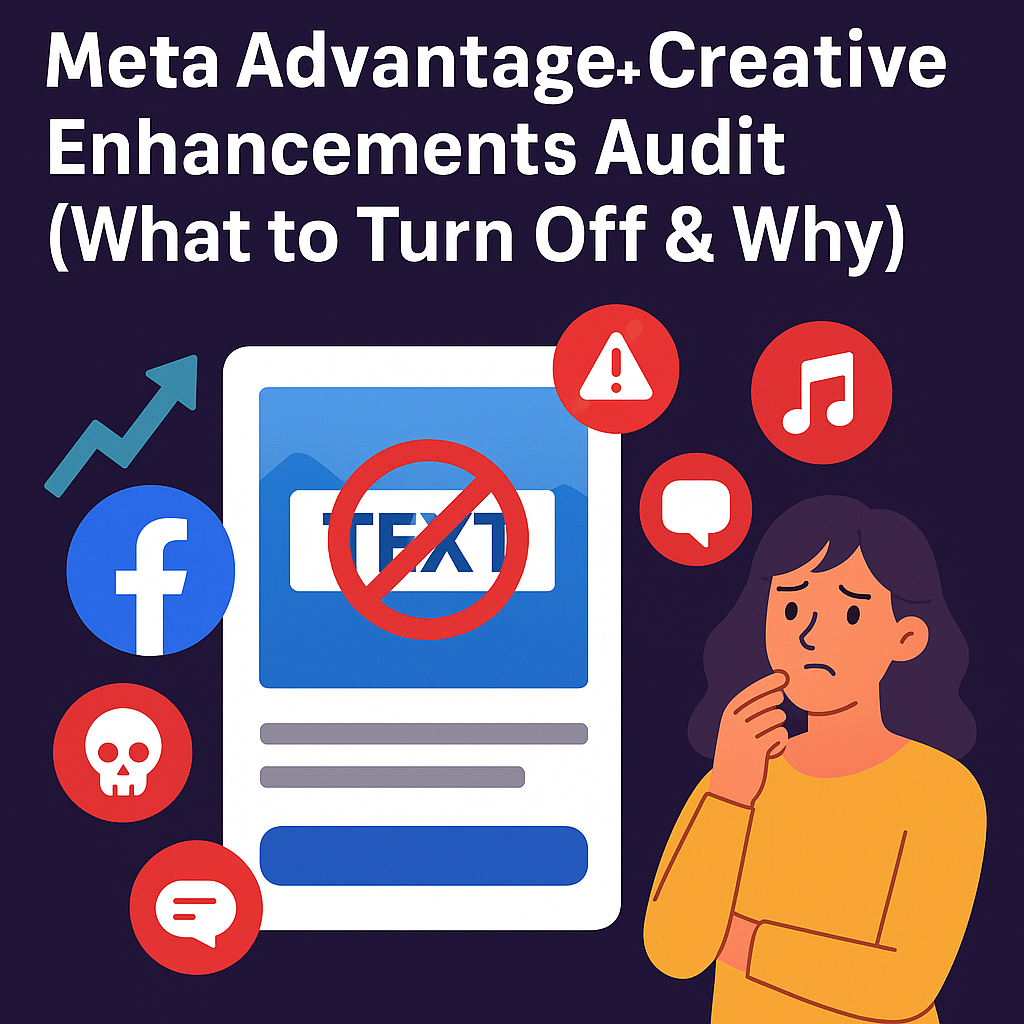The meta advertising strategy 2025 demands is radically different from what worked in 2024. As the platform becomes more automated and privacy-centric, many advertisers are overcomplicating their campaigns and paying the price.
Bloated structures, endless audience tests, and reactive tweaks often stall the learning phase and confuse Meta’s algorithm. The result? Wasted ad spend and unpredictable results.
But here’s the truth: successful Meta advertising in 2025 is all about simplification. When you align with Meta’s AI, simplify your structure, and focus on high-quality creative, you can finally unlock consistent performance at scale.
In this Meta ads guide 2025, we’ll walk you through 20 proven principles to help you simplify Facebook ad campaigns, take advantage of automation tools like Advantage+, and build a profitable, predictable growth engine.
Table of Contents
Why Simplifying Your Meta Advertising Strategy in 2025 Works Better
In the current Meta advertising environment, the old ways of thinking often lead to diminishing returns. It’s time to shift your perspective and embrace the power of simplification and the inherent intelligence of Meta’s algorithms. As we navigate Meta ads in 2025, complexity has become a detriment, not an advantage.
The 20 Rules for Meta Ad Success in 2025
Here are the core principles that will guide your meta advertising strategy 2025 toward predictable, consistent results.
| Principle | Core Concept | Action |
| 1. Simplicity | Avoid over-segmentation | Consolidate campaigns for better learning. |
| 3. Literal Algorithm | Optimize for your true business goal | Choose ‘Purchases’ or ‘Leads’, not ‘Clicks’. |
| 4. Targeting Control | Meta’s AI handles audience finding | Use broad targeting; trust Advantage+. |
1. Simplify Facebook Ad Campaigns for Better Results
It might sound counterintuitive. Many believe a more complicated approach signals greater sophistication and, therefore, better results. But with how Meta’s advertising platform operates today, simple is almost always better. Prioritize fewer campaigns focused on your primary goals. Resist the urge to create countless ad sets for granular audience segmentation. Avoid complexity unless it’s absolutely necessary.
A simplified approach offers numerous benefits: it consolidates your budget, giving your ads the best chance to perform optimally. It helps you exit the learning phase faster and achieve stable results, ensuring Meta’s AI has enough data to truly learn and optimize. Perhaps most crucially, it helps assure that the results you do see are meaningful and statistically significant.
Complex campaign structures that spread your budget across numerous assets often lead to small sample sizes, making it nearly impossible to get an accurate read on what’s working. While it doesn’t mean you should always stick to a single campaign and ad set (though this might be ideal for many), simplicity should be your default, with complexity added only when a clear, data-driven need arises.
2. No One Meta Ads Strategy Works for Everyone—Here’s Why
One reason the simplified approach to Meta ads isn’t always popular is that it’s hard to package and sell. Any social media “guru” can scream about their complex, “guaranteed” advertising system, and it sounds appealing. But there’s no such thing as a guaranteed strategy for results.
Limitless variables impact your outcomes: your industry, brand reputation, budget, product price point, website performance, and, crucially, your ad copy and creative. You can copy someone else’s “effective” strategy, even a competitor’s, and get completely different results. Understand that your advertising’s effectiveness has very little to do with campaign construction or the specific levers you pull.
While you should simplify to eliminate noise and set yourself up for the best chance, no single setting or lever will force people to buy from you. Once the complexity is stripped away, your results rely heavily on the effectiveness of your ads themselves.
3. Why Meta’s Ad Algorithm is Literal—and How to Use It
Realizing this principle is arguably the single most important point for understanding your role as an advertiser in 2025. Your campaign objective means very little; it’s your performance goal that defines how your ads will be delivered.
When you set a performance goal like link clicks, landing page views, or conversions, Meta’s algorithm zeroes in on that specific action. It shows your ads to people most likely to take it and measures success purely by whether they do.
This literal interpretation can be both a blessing and a curse. It’s a blessing when optimizing for purchases, as you and the algorithm are aligned on the ultimate goal. But it can lead to problems if you choose top-of-funnel objectives. For instance, optimizing for “link clicks” might yield a high CTR, but the algorithm doesn’t care about their intent; it only cares about getting the click you defined. These clicks can be accidental, from “click-happy” users, or even from bots.
Similarly, optimizing for “leads” will get you leads, but the algorithm won’t care about their quality. This literal nature explains why optimizing for top-of-funnel actions is often a waste of money and why Meta might spend your budget on demographics that provide cheap but unqualified leads. This is also why optimizing for a purchase or qualified lead should be your priority.
Understanding how literal Meta’s AI is will fundamentally reshape your meta advertising strategy 2025 because optimization begins with the right performance goal.
4. Broad Targeting vs Detailed Targeting: What Actually Works in 2025
There was a time when defining the right audience was considered the advertiser’s most important role. After all, even the best ads wouldn’t work if they weren’t seen by the right people. While it remains crucial that the right people see your ads, this has very little to do with manual targeting control anymore. In fact, most of our traditional control over targeting is gone.
We retain certain customizations that give the illusion of control: age minimum and maximum, gender, lookalike audiences, and detailed targeting (interests and behaviors). However, if you optimize for conversions (and you should, given the algorithm’s literal nature), most of your inputs are merely audience suggestions.
You can enforce strict controls for age minimums (up to 25 years old), location (people living in or recently in that location), and excluded custom audiences. But almost everything else is a suggestion by default and, in some cases, cannot be restricted. Our tests and industry observations suggest that these audience suggestions often do little to impact who actually sees your ads. The result: the algorithm is going to reach whom it wants to reach.
This might sound alarming, but it’s actually liberating. There’s less reason to create multiple ad sets to test targeting segments. You don’t need to waste time trying to isolate the best-performing lookalike audiences or detailed targeting. While there are times when you can control targeting, these are often when the effectiveness of advertising is most questionable.
Yes, you should add audience constraints when optimizing for link clicks, landing page views, and other top-of-funnel actions because you’ll otherwise get horribly low-quality results. Detailed targeting still plays a role in TOF education campaigns, particularly for brands with niche audiences or limited pixel data. But even your controls can’t completely fix the weaknesses in that optimization. Let go of the need to control your targeting; it’s largely an illusion now.
This is especially true for Advantage+ campaigns, which are designed to find your ideal customer efficiently.
5. When to Trust Meta’s Default Settings (And When You Shouldn’t)
Up to this point, we’ve emphasized a simplified approach to Meta advertising: simple campaign construction, fewer ad sets, and minimal customization from Meta’s defaults. This includes prioritizing the default attribution setting when optimizing for conversions, the default bid strategy, and the default placements.
Of course, there are exceptions. There are times when you should customize attribution settings (e.g., removing 1-day view or focusing on 1-day click). There are times when you might consider setting a cost-per-result goal, a bid cap, or a ROAS goal. There are times when you should restrict your audience by age or gender. And there are times when you should remove Audience Network or other placements.
The key point is that these are exceptions. You should normally stick with the defaults, especially if you don’t have expert knowledge or concrete data supporting a deviation. The defaults are generally sufficient and often lead to better average results.
Customizations should only be considered when you need to solve a proven problem based on how things work, not on a gut feeling. You shouldn’t restrict your audience by age and gender simply to match your “ideal customer” if you’re optimizing for purchases; Meta should distribute your budget optimally to get the most results.
You shouldn’t need to remove the Audience Network placement when optimizing for conversions; if a placement doesn’t lead to your desired action, the algorithm will adjust. Approach customizations with a clear understanding of the algorithm’s strengths and weaknesses, supported by empirical results. This is one of the most underrated levers in your meta advertising strategy 2025, especially when trying to reduce human error.
How Ad Creative and Copy Drive Results in Meta Ads
With less emphasis on manual targeting and campaign complexity, your attention must shift to where you still wield immense power: your ads. This is where your facebook ad creative tips come into play.
6. Rethinking Remarketing: Let Meta Handle It Automatically
Our approach to remarketing has evolved significantly over the past few years. There was a time when remarketing made up a substantial portion of our ad budgets, and it made sense. If you could segment people who bought from you, subscribed to your email list, visited your website, or engaged with your Facebook or Instagram content, why wouldn’t you target them?
These are the people most likely to know who you are and perform your desired action.
However, algorithmic targeting has changed this. Meta’s Advantage+ Audience (which is now the default targeting) prioritizes your pixel activity, conversion history, and prior engagement with your ads before extending more broadly. In essence, you don’t need to explicitly tell Meta to target your website visitors; it’s already happening because Meta knows these are people likely to convert.
You can verify this by using audience segments within the Sales objective. Assuming you’ve defined your engaged audience and existing customers in Advertising Settings, you can break down results to see how much of your budget was spent on remarketing, even without explicitly targeting remarketing audiences.

We often observe that 20-30% (or more) of a broad campaign’s budget is naturally spent on remarketing, not even counting prior engagement with Facebook and Instagram content (which can’t be used for defining audience segments).
So, the first reason you don’t need to heavily rely on standalone remarketing is that it happens naturally when targeting broadly. It’s often less efficient to segment that group when you can include them in a broader, less expensive audience.
Remarketing also has other challenges: It’s generally not scalable. Most advertisers have limited remarketing audiences, which are quickly exhausted. While broad targeting (including remarketing) allows for budgets of hundreds or thousands of dollars daily, this isn’t often feasible with remarketing alone. Minimal budgets lead to minimal lifecycles. It’s also often not incremental.
Many who insist on remarketing point to “amazing results,” but these are often padded with view-through conversions from people who may not have even seen the ad. Even when someone converts after clicking, it’s unclear how much your ad contributed, as they might have converted from another source eventually.
We’re not saying these audiences are worthless, and there are specific situations where explicit remarketing makes sense. But understand that remarketing happens naturally and be aware of its potential pitfalls.
7. Your Meta Ad Creative Now Does the Targeting—Here’s How
We’ve established that you should largely simplify your campaign structure and, with few exceptions, let the algorithm do its thing without much manual targeting intervention. But this doesn’t mean you’ll automatically get good results. This is where the power of your Facebook ad creative shines.
You define your desired action with the performance goal, and Meta’s ad delivery algorithm focuses on getting you those actions. But ultimately, you retain significant control over performance through your ads themselves. Your ad copy and creative must appeal directly to your ideal audience. They need to lean into their pain points and offer a solution. Your ad should be so compelling that clicking it helps solve a specific problem for the viewer.
If you’re not getting the results you want, whether it’s low-quality leads, or clicks from people who aren’t your ideal customers start by examining your ads. Make it crystal clear who your product is for. Just as importantly, be clear about who it’s not for. You want to attract your ideal audience and repel those who are a bad fit. While many theorize that Meta scans ad copy to determine who sees your ads, it might be simpler: Meta’s ad delivery algorithm considers how people respond to your ad.
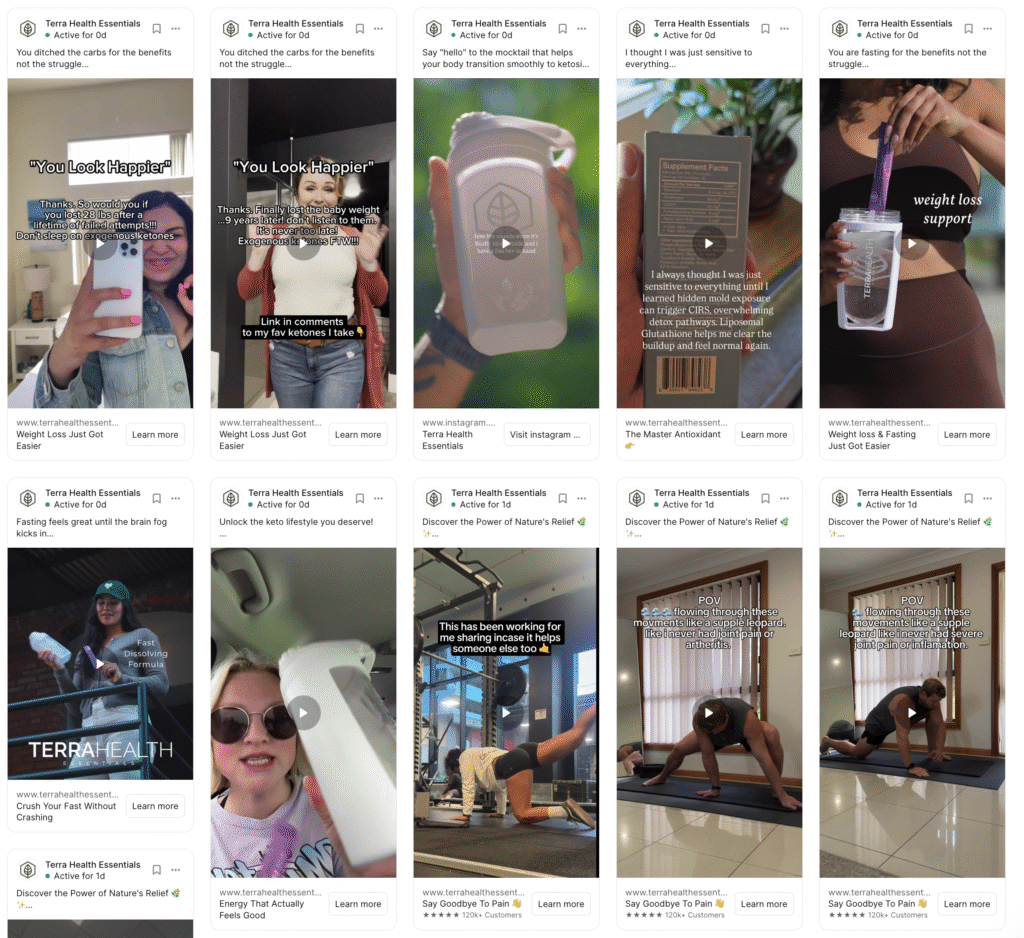
Adjustments are made based on who does and doesn’t perform your goal action. That’s why your ad copy and creative essentially do the targeting now. By attracting the desired actions from your ideal customer, you ensure your ad is shown to more people like them. If your ad repels a certain type of person who doesn’t perform the action you want, the algorithm will adjust.
Apply this knowledge to your lead forms; if you’re getting low-quality leads, ask qualifying questions that prevent unsuitable candidates from completing the form.
8. Feed Meta’s Algorithm Multiple Creatives for Better Results
Ad construction looks very different these days. Not long ago, it meant providing a single image or video, primary text, headline, and description. While exceptions existed (carousels, dynamic creative), most advertisers stuck to the standard method.
Things are different now. When you create an ad, you can provide up to five primary text, five headlines, and a description. You can also accept an additional five AI-generated primary text and headline options. But the variations don’t stop there. As of 2025, there are over 26 placements across Meta’s ecosystem. An optimized ad looks different across placements, so we should consider customizing when necessary.
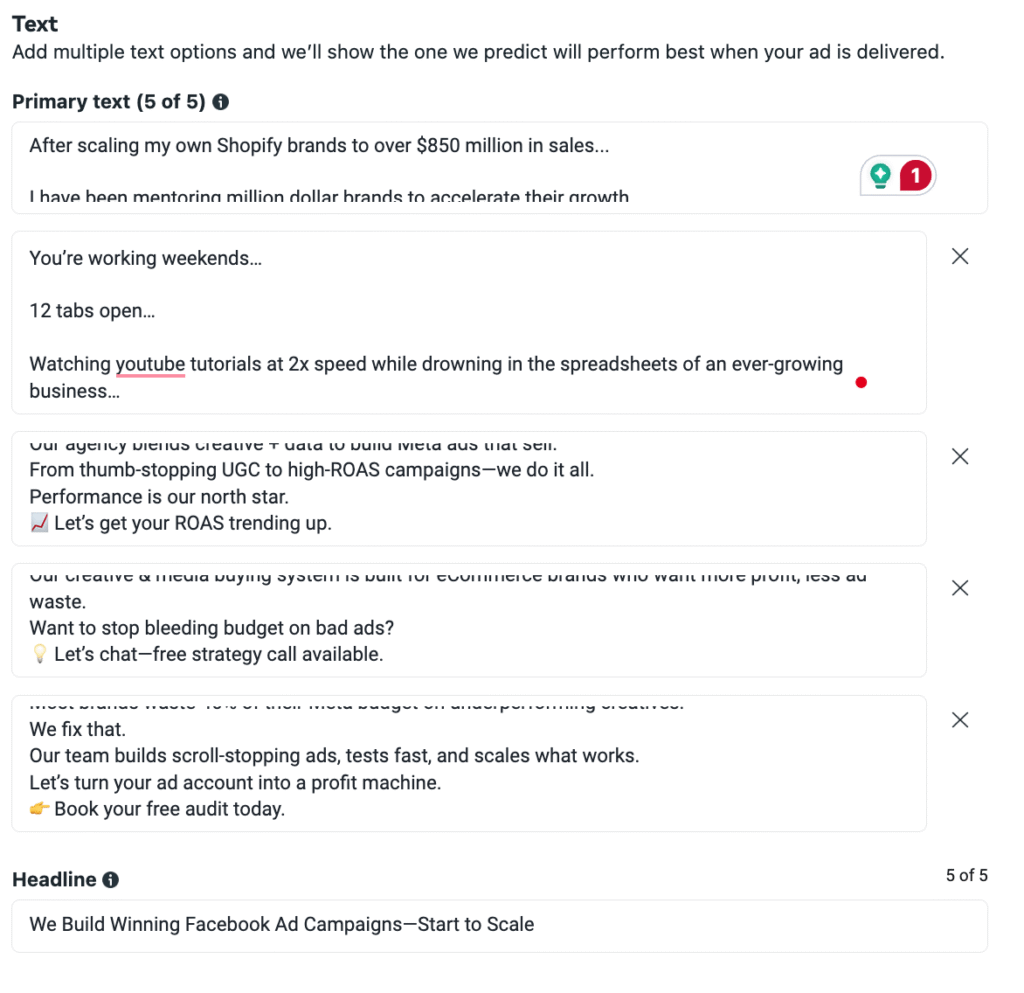
Features like Dynamic Creative and Flexible Format are also options, meaning you can provide up to 10 images and/or videos (and sometimes as many as 30 for Flexible Format) for a single ad. Even if you don’t use those methods, you can submit multiple creatives. Advertisers can accept AI-generated images and background variations in addition to their primary creative. You can also accept “related media” from other ads to give Meta additional creative options.
We don’t know which text and creative will be shown to which person in which placement, nor do we know what will perform best without testing. Our main role now is to give Meta options. This doesn’t mean creating variations for variation’s sake; you don’t want to dilute your quality with low-quality copy and creative, or you’ll get low-quality results. Be intentional. But we should look at copy and creative more holistically. Ensure Meta has options that will work for the right person in the right placement.
This could involve generating these options within a single ad or through multiple distinct ads. Bad performance today is usually tied to your copy and creative. The better job you do of providing the algorithm with suitable options, the greater your chance of achieving good results.
9. One Facebook Ad Now Powers Many Variations—Use It Wisely
Building on the previous point, it’s crucial to understand that what you perceive as “one ad” is, to Meta’s algorithm, a multitude of potential winning combinations. Meta dynamically combines your provided text, headlines, descriptions, and creative assets to present the most relevant version to each user.
This means your focus should be on ensuring that each individual component you provide is strong and capable of standing alone, rather than trying to perfectly craft a single, static message. The algorithm experiments, learns, and serves the blend that maximizes your desired outcome. This approach is key to how to structure Meta ads effectively for automated delivery.
10. Kill Your Darlings: Rotate Ads to Avoid Facebook Ad Fatigue
This might be one of the hardest principles for many advertisers. After pouring effort into crafting compelling ad copy and designing stunning visuals, it’s natural to feel a connection to your creations. However, in the world of Meta advertising, data must be your only guide.
Be prepared to be ruthless with underperforming creative. If the numbers show an ad isn’t converting, gaining traction, or meeting your KPIs, it’s time to kill it, regardless of your personal preference or how much you love it. Your campaigns are not art projects; they are performance vehicles.
The sooner you detach emotionally and let the data dictate your decisions, the faster you’ll find winning strategies and allocate your budget effectively. This helps combat ad fatigue on Facebook and Instagram by ensuring fresh, high-performing creative is always in rotation. Regularly rotating creative should be a non-negotiable in your meta advertising strategy 2025 playbook.
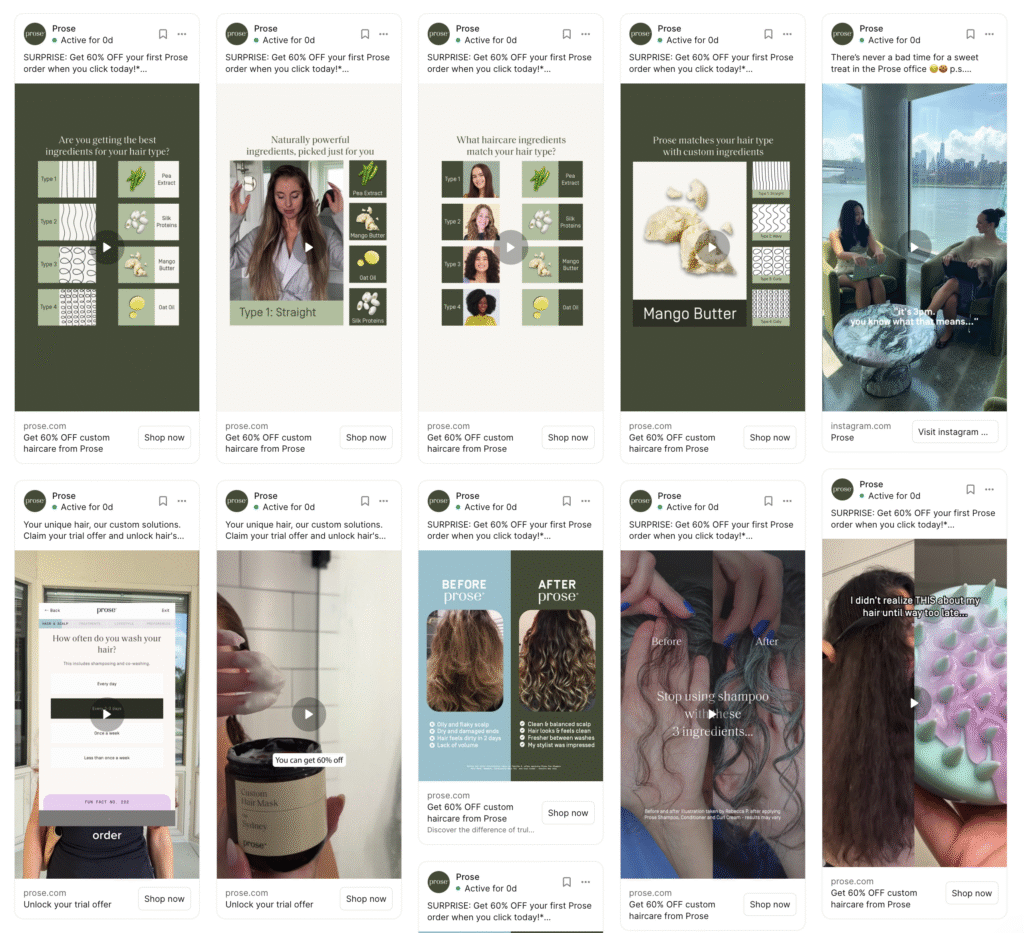
Using Motion, we tracked how our competitors refreshed creative every 7–14 days, a sequence we adopted to reduce ad fatigue and keep sales going.
Data, Testing & Strategy Execution
Effective Meta advertising in 2025 requires more than just understanding the technical aspects; it demands a disciplined, data-driven mindset and an unwavering commitment to ethical practices. This section focuses on essential Meta ad algorithm tips and how to execute your strategy.
11. Why Micromanaging Hurts Your Campaigns (Especially During the Facebook Ads Learning Phase)
Meta’s algorithms are incredibly sophisticated and need time and data to optimize effectively. A common mistake advertisers make is micromanaging their campaigns by making frequent, small changes. This constant tinkering can pull your ad sets out of the Facebook ads learning phase repeatedly, preventing the algorithm from gathering sufficient data to learn and improve.
Resist the urge to adjust bids, budgets, or creative daily. Instead, allow your campaigns enough time to stabilize and gather meaningful results. Typically, this means letting an ad set run for at least 3-5 days, ideally aiming for 50 conversions within a 7-day period, before making significant optimization decisions. Trust the system to do its job, and intervene only when there’s a clear, consistent trend in the data.

12. Master Meta Ads Attribution Models to Measure What Matters
Understanding how Meta attributes conversions is the REAL difference maker. Meta’s default attribution settings (e.g., 1-day click and 7-day click, 1-day view) are designed to credit the platform for actions that occur within specific windows after someone clicks or views your ad. However, these defaults might overstate Meta’s direct impact if not understood in context with your broader marketing efforts.
It’s your responsibility to understand these models, how they interact with your sales cycle, and to consider setting up custom attribution models or using incremental attribution tools if your business requires a different view. Knowing your actual break-even KPIs and comparing Meta’s reported results against your internal CRM or analytics data is crucial for truly understanding campaign profitability.
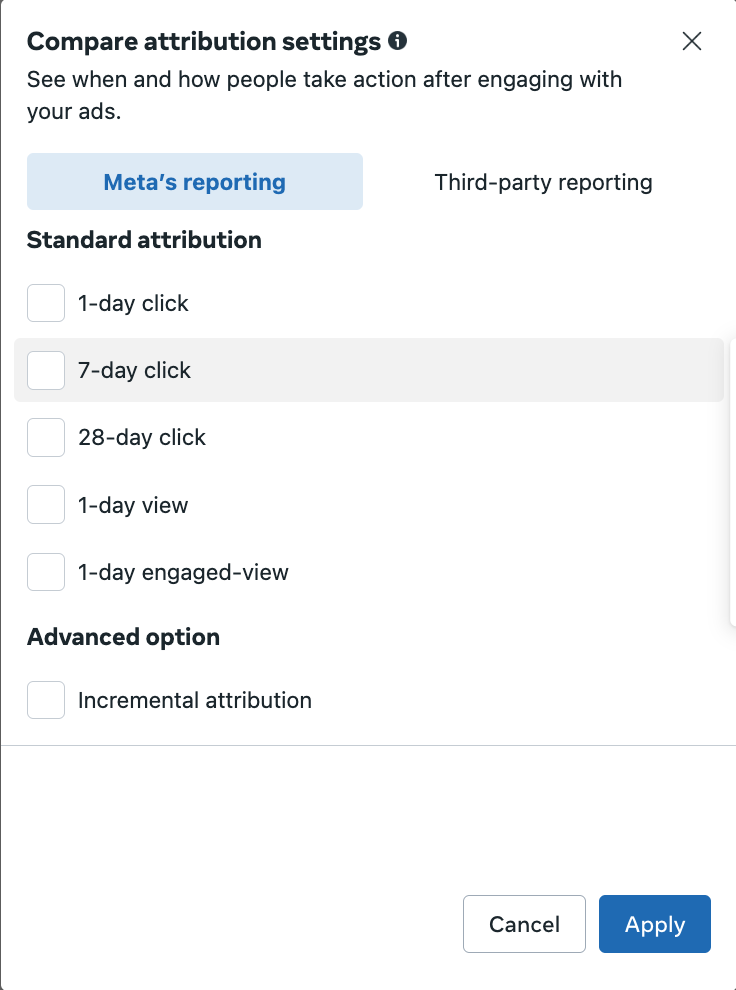
13. Stop Blaming Meta Ads—Fix Your Offer, Copy, or Funnel Instead
When results are poor, it’s easy to point fingers at the Meta algorithm, “iOS updates,” or “the platform.” However, the truth is, the system is designed to deliver on the goal you set. If your leads are poor quality, or your sales aren’t materializing, the problem almost invariably lies in something you control: your offer, your ad creative and copy, or your landing page/website experience.
The algorithm is literal; if you tell it to get you clicks, it will get clicks. If it gets you low-quality leads, it means your ad is attracting low-quality leads. Focus your energy on refining your message, improving your creative, strengthening your offer, and optimizing your funnel, rather than faulting the underlying delivery mechanism.
It’s time to rebuild your Meta advertising strategy 2025 from the ground up—starting with your message, offer, and funnel.
14. Optimize for Business Outcomes—Not Vanity Metrics
A smart meta advertising strategy 2025 centers around real outcomes not vanity metrics. High click-through rates (CTR) or impressive reach figures might look good on a report, but they mean little if they don’t translate into tangible business outcomes.
Always prioritize meaningful results that directly impact your bottom line. These include purchases, qualified leads, customer lifetime value (LTV), and ultimately, Return on Ad Spend (ROAS) or Cost Per Acquisition (CPA). If a metric doesn’t directly contribute to your core business objective, it’s a secondary consideration at best.
15. Track ROAS and CPA: The Only Metrics That Truly Matter
Building on the previous principle, be laser-focused on the Key Performance Indicators (KPIs) that truly drive your business forward. For most advertisers, this means Cost Per Acquisition (CPA) and Return on Ad Spend (ROAS). These metrics tell you whether your ads are profitable. While other metrics like frequency, CPM, or audience size can provide diagnostic information, they should not be your primary drivers for optimization decisions.
If your CPA is too high or your ROAS is too low, that’s where your attention must be. Don’t get distracted by what feels good; focus on what truly impacts your profitability.
16. Don’t Confuse Correlation with Causation—Test Strategically
In data analysis, it’s a common trap to assume that because two things happen together, one caused the other. For example, if you change your ad creative and sales go up, did the creative cause the sales increase, or were there other contributing factors (e.g., a holiday, a competitor’s price change, an external event)?
Always strive to isolate variables when testing and apply a scientific mindset. True understanding comes from designing tests that prove causation, not just observe correlation. If you change multiple elements at once, you’ll never know which one drove the result.
17. Context Is King: Why “It Depends” Is the Right Meta Ads Answer
One of the most frustrating but truthful answers in digital marketing is “it depends.” There is no universal rule or magic bullet that applies to every business, every industry, or every product. What works for a high-ticket B2B service might not work for a low-cost e-commerce product. The best approach for a well-established brand might differ greatly from that for a startup. Be flexible in your thinking.
Be open to testing assumptions. Recognize that context is king, and a strategy that delivers exceptional results for one client may utterly fail for another. Your ability to adapt and say “it depends” will serve you far better than rigidly adhering to a single methodology.
18. Refresh Your Meta Ad Assumptions Constantly
The Meta advertising landscape is dynamic; it changes constantly with new features, algorithm updates, and evolving user behaviors. Strategies that worked flawlessly last year might be ineffective this year. It’s vital to continuously update your assumptions about how the platform works and what drives performance. No Meta advertising strategy 2025 should rely on last year’s tactics
Rely on current data, industry trends, and ongoing experimentation rather than clinging to outdated beliefs. Be a student of the platform, always learning, always adapting. Staying informed and flexible is the only way to maintain a competitive edge and optimize your Meta advertising strategy 2025.
Your meta advertising strategy 2025 should evolve every quarter to stay aligned with platform and consumer behavior shifts.
19. Ethical Meta Advertising Is a Competitive Advantage in 2025
In an increasingly scrutinized digital advertising world, maintaining trust with your audience and adhering strictly to platform policies is the only way forward. Be ethical to a fault in all your advertising efforts. This means being transparent about your offers, avoiding deceptive practices, respecting user privacy, and ensuring your ads comply with Meta’s advertising policies.
Long-term success on Meta (and any platform) relies on building and maintaining a positive reputation. Cutting corners or engaging in “grey hat” tactics might offer short-term gains, but they inevitably lead to account issues, trust erosion, and ultimately, failure. Ethical advertising isn’t just a moral imperative; it’s a fundamental business strategy.
20. Use AI Tools Ethically to Scale Creative and Strategy
Meta advertising in 2025 isn’t just powered by AI, it’s shaped by how you, the advertiser, use AI tools to build and test ideas. Whether you’re generating creative variations, analyzing ad performance, or scripting UGC content with the help of AI, these tools can be powerful force-multipliers when used ethically.
But don’t outsource your thinking. AI tools should support your strategic decisions, not replace them. Always review AI-generated copy and creative for accuracy, tone, and compliance with Meta’s ad policies. Misusing AI can lead to tone-deaf messaging, ad rejections, or even account issues. When used responsibly, however, AI lets you test faster, iterate smarter, and optimize your Meta ad campaigns with scale.
Conclusion: Facebook Ads Simplified – How to Win in 2025
The Meta advertising landscape in 2025 and beyond is defined by its powerful, AI-driven algorithms and a clear shift towards automation. For advertisers seeking consistent, predictable results, the path forward is not through increased complexity but through intelligent simplification and a profound understanding of how these advanced systems operate.
By embracing these 20 principles, your Meta advertising strategy 2025 can become more resilient and ROI-driven. Focus on delivering high-quality, diverse creative, measure what truly matters to your business, and continuously adapt your strategy based on meaningful data. This isn’t just theory, it’s Facebook Ads Simplified for maximum performance.
The future of Meta advertising rewards those who can work with the machine, not against it, allowing for greater efficiency, higher performance, and scalable growth. Avoid the common pitfalls of micromanagement and misguided targeting, and you’ll be well on your way to successful Meta advertising in this evolving digital age. There’s no better time to rebuild your meta advertising strategy 2025 for long-term profitability and scale.
All 20 rules we implement across 25+ DTC Meta Ad Accounts we currently
Meta Ads FAQ: Strategies, Creative Tips, and Campaign Optimization
What’s the best Meta Ads strategy in 2025?
A simplified meta advertising strategy 2025 is built on automation, Advantage+, and conversion-focused creative. A simplified structure focused on broad targeting, optimized for purchases or qualified leads, and driven by high-quality, diverse ad creative is key for Meta ads in 2025. Embrace Meta’s automation (like Advantage+) rather than fighting it.
Does Meta’s Advantage+ replace manual targeting?
In most cases, yes. Meta’s Advantage+ suite leverages advanced AI and conversion data to find high-probability users—even without strict manual targeting settings. While you can provide suggestions, the algorithm will often expand beyond them to find the best converters.
How do I fix poor Meta Ads performance?
Focus on what you control: your ad copy, creative, the quality of your offer, and your landing page experience. Also, ensure your performance goal aligns with your true business objective (e.g., purchases, not clicks). The issue is rarely the algorithm itself; it’s usually the input you provide.
Why is the Facebook ads learning phase important?
The Facebook ads learning phase is crucial because it’s when Meta’s algorithm gathers data to understand how to best deliver your ads for your chosen objective. Constant changes can restart this phase, hindering optimization and leading to inconsistent results.
What is ad fatigue on Facebook, and how do I prevent it?
Ad fatigue on Facebook occurs when your audience sees your ads too many times, leading to decreased engagement and higher costs. Prevent it by regularly refreshing your ad creative and copy, expanding your audience (if appropriate), and leveraging Meta’s dynamic creative options to automatically rotate variations.
What’s the difference between broad targeting vs. detailed targeting now?
In Meta ads in 2025, broad targeting (with minimal audience constraints) is often recommended when optimizing for conversions, as Meta’s AI is powerful enough to find ideal customers. Detailed targeting (interests, behaviors) acts more as a suggestion, and the algorithm may expand beyond it. Use detailed targeting primarily for very niche audiences or for upper-funnel objectives where you need more control.
Is Facebook ads simplified still effective in 2025
Yes. Facebook Ads Simplified isn’t a beginner tactic—it’s the strategic default for high-performing campaigns in 2025.

